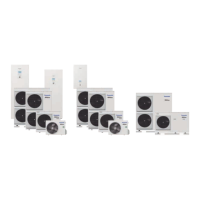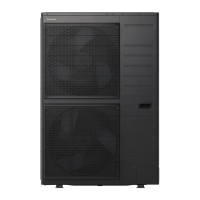
Do you have a question about the Panasonic AQUAREA WH-UXZ12KE5 and is the answer not in the manual?
| Model | WH-UXZ12KE5 |
|---|---|
| Category | Heat Pump |
| Brand | Panasonic |
| Heating Capacity | 12 kW |
| Energy Efficiency Class (Heating) | A+++ |
| Energy Efficiency Class (Cooling) | A++ |
| Refrigerant | R32 |
| Series | AQUAREA |
| Operating Temperature Range (Heating) | -20°C ~ +35°C |
Covers warnings, symbols, and general advice for safe operation and installation.
Focuses on safety during electrical work, wiring, and water system installation.
Details safety measures for installation locations and handling of unit materials.
Provides specific precautions for handling R32 refrigerant, including installation and servicing.
Covers safety procedures and precautions for personnel performing servicing and work.
Covers leak detection methods, refrigerant recovery, evacuation, and charging procedures.
Installer setup for heating operation parameters like water and outdoor temperatures.
Visual representation of the system's refrigerant and water cycle flow.
Detailed wiring diagram illustrating connections for the indoor unit.
Detailed wiring diagram illustrating connections for the outdoor unit.
Guidelines for determining the required indoor floor area based on refrigerant charge.
Guidelines for selecting the optimal installation location for the indoor unit.
Instructions for installing refrigerant and water piping for the indoor unit.
Instructions for safely connecting power supply and communication cables to the tank unit.
Guidelines for proper wire stripping and connecting techniques for electrical safety.
Guidelines for selecting an appropriate and safe installation location for the outdoor unit.
Diagrams and instructions for installing the outdoor unit, including drain water disposal.
Detailed instructions for connecting refrigerant piping to the outdoor unit.
Procedure for performing air tightness tests and leak checks on the refrigeration system.
Instructions for connecting power supply and communication cables to the outdoor unit.
Flowchart detailing the installer setup menu options, including optional PCB connectivity.
Setup parameters for heating operation, including water and outdoor temperatures.
Setup parameters for cooling operation and auto mode switching based on temperatures.
Setup parameters for tank operation including floor time, heat-up time, re-heat temperature, and sterilization.
Overview of service and maintenance procedures, including accessing maintenance menus.
Guidelines for installing and servicing heat pumps using R32 refrigerant.
Comparison of R32 vapor pressure characteristics with R410A and R22.
List of essential tools required for R32 refrigerant piping installation and services.
Step-by-step procedures for new installation, relocation, and repair of the refrigerant cycle.
Details on copper pipe requirements and the process of flaring for R32 systems.
Procedure for air purging and gas leak testing using a vacuum pump.
Step-by-step instructions for the process of recovering refrigerant from the system.
Procedure for correctly re-inserting refrigerant into the system after service.
Preparation steps and safety considerations for brazing refrigerant cycle components.
Guide to selecting appropriate BAg brazing materials based on composition and application.
Criteria for checking brazing insert points, including impurity, gap space, and insertion size.
Overview of basic inverter control functions and detailed heating operation.
Details on cooling operation, thermostat control, and setting target water temperatures.
Control logic for the indoor electric back-up heater in normal and force modes.
Tank heater selection and internal heater control logic at tank mode.
Control details for optional base pan heater and force heater mode.
Detailed control logic and conditions for force heater mode operation.
Details on expansion tank, water pump, and back-up heater anti-freeze controls.
Control logic and conditions for the operation of the three-way valve.
Control logic for two-way valves and external OFF/ON functionality.
Functions and operation details for the external compressor switch.
Explanation of the heat/cool switch functionality and its control logic.
Detailed logic and settings for SG Ready control via digital input.
SG Ready control logic for capacity and temperature adjustments based on digital input.
Details on protection controls applicable to all operations, including time delays and current limits.
Protection controls related to high pressure sensors and outdoor temperature current.
Protection controls specific to heating operation, including outdoor air temp and deice.
Protection controls specific to cooling operation, including outdoor air temp and freeze prevention.
Step-by-step guide for performing pump down procedures on the system.
Instructions on how to adjust the pump speed using the remote control.
Procedure for setting the EEPROM to factory default data.
Guide to diagnosing malfunctions in the refrigeration cycle system.
Relationship between unit conditions, pressure, and electric current for troubleshooting.
Explanation of the self-diagnosis function and how to check error codes.
A table listing error codes, abnormality descriptions, and primary locations to verify.
Continuation of the table listing error codes and their primary verification locations.
Troubleshooting steps for connection capability rank abnormality (H12).
Troubleshooting steps for outdoor high pressure protection activation (H98 / F95).
Cooling troubleshooting for outdoor high pressure protection activation (H98 / F95).
Troubleshooting steps for indoor freeze-up protection (H99).
Troubleshooting steps for outdoor high pressure switch activation (F12).
Troubleshooting steps for compressor rotation failures (F14).
Troubleshooting steps for outdoor fan motor mechanism lock (F15).
Troubleshooting steps for input over current detection (F16).
Troubleshooting steps for compressor overheating (F20).
Troubleshooting steps for IPM overheating (F22).
Troubleshooting steps for output over current detection (F23).
Troubleshooting steps for refrigeration cycle abnormalities (F24).
Troubleshooting steps for four-way valve abnormalities (F25).
Troubleshooting steps for outdoor high pressure switch abnormalities (F27).
Troubleshooting steps for low discharge superheat conditions (F29).












